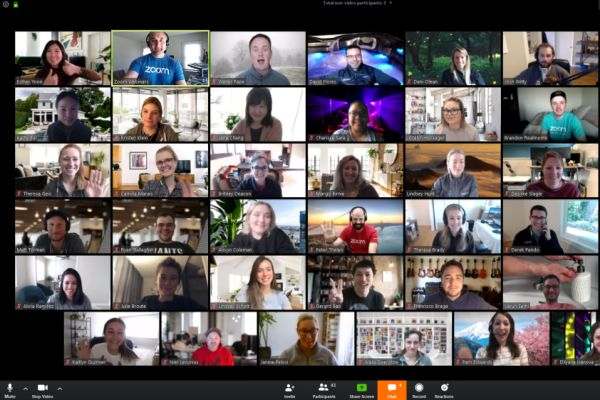Published on the 19/05/2020 | Written by iStart

(And the tech to support them…)
Virtual events, online meetings, webcasts or webinars – call them what you will – are an effective and efficient alternative to in-person events.
They offer a platform to stay connected, build community or engage with clients or prospects, just as you would do with a physical event.
But just because the technology is easily accessible and the bar for attendance is low, doesn’t mean success is a given. With in-person options severely constrained under Covid-19 restrictions, marketers are scrambling to be heard amongst a din of competing online events across the world.
“There are some unique challenges that those new to the medium need to adapt plans around.”
To be successful, many of the same challenges that exist in creating engaging events offline also apply in the online realm. But there are some unique challenges that those new to the medium need to adapt plans around.
The Technology
By now, we’ve probably all engaged in some form of online work or social video meeting.
Through Skype, Teams, Facebook Messenger, Zoom, or a multitude of others, we’ve become familiar with connecting with friends and colleagues remotely.
We’ve probably also experienced the downsides. Background noise, connection or streaming issues, interruptions or a dominant attendee can all detract from the experience.
But for costs that range from free to tens of dollars a month, you can put up with it when bantering amongst friends and colleagues.
However, for a professional B2B or all-of-staff presentation you need a more controlled platform. This is when online meeting tools fall short – you need a webinar.
Webinar events are typically connecting people who do not know one another. They are attending out of a personal interest or to learn more about a topic. Invitations are needed to advertise the event and convert interest into registrations. Registered attendees need to be sent reminders and calendar updates, and their details need to be retained for follow up after the event.
To handle all that, you need a proper webinar tool, and that involves either taking up a paid subscription or engaging a partner.
If your organisation does not have a webinar platform, a Google search will quickly confirm that there are multiple products, features and pricing plans available.
Zoom (the webinar version), WebEx and GoToWebinar are the most commonly used in this part of the world, with Bluejeans also emerging. The products and prices are not all equal, so take the time to set up trial licenses and give the product a proper run through prior to purchase to make sure it meets your needs.
Look for features like customised registration pages, automated reminders, waiting rooms, multi-speaker views, recording, Q&A, live polls, integrated exit surveys etc.
Costs for a complete webinar platform range from around $50 to $500 a month, depending on features and maximum audience size.
Virtual Conferencing
If you are looking to create a more engaging experience, potentially with paid ticketing, you can move further upmarket into virtual conferencing systems. These are split into two categories:
- Video streaming – which involves broadcasting live ‘speaker-on-stage’ events to remote attendees. Livestream and Brightcove are the leaders in this category, integrating industry-standard camera and audio feeds into a production console and broadcast quality streaming service.
- Virtual conferencing – these seek to emulate the trade show experience for attendees, providing facilities such as break-out rooms, simultaneous presentations, live Q&A with speakers, casual chat between attendees etc. On24 and vFairs are examples of such platforms.
Costs for both these categories run into the thousands per event – typically $5,000-$10,000, or may be priced at the upper end of that range on an annual subscription for a capped number of events per year.
The environment requires significant configuration to set up so expect to also engage specialist services to assist with this aspect also.
VR/AR is emerging in this category (think salesmen as avatars roaming the virtual exhibition hall) but is more gimmicky than useful and a distraction away from the content attendees are wanting to see.
Hosted Platforms
You can also engage a partner to run webinars, using their platform of choice.
Under this scenario, you effectively outsource event management (including the platform, event collateral, promotion and all administrivia) to a partner.
Some publishers, event managers and even industry associations are offering hosted webinars with paid sponsorship options. Typically, they choose the theme and speakers and try to attract sponsors, so as a sponsor it is a matter of finding the right theme that fits your objectives and will attract the right audience.
iStart’s ‘Lunch Box’ webinars are another option. Our point of difference is that we usually work with a single sponsor and tailor an event to meet the sponsor’s specific objectives. We also come with our own database of prospects, promoting events to our subscribers who are Australia and New Zealand’s business and IT decisionmakers.
Tips for a Successful Event
- You get the audience your content deserves. Take the high road with educational, high value content and quality speakers your target audience can relate to. People will not register for a sales pitch.
- Independence delivers credibility. Companies who promote their own webinars, particularly with staff as presenters, are tarred with the perception that the event will be a sales pitch. Sadly, perception is very often reality.
- Be interesting. Would you attend your webinar? Be brave, be creative and challenge yourself with that question. Being intelligent and professional doesn’t mean being boring. Have some fun, leverage your interesting clients or wider sports or other sponsorships. But please, don’t be boring.
- Don’t script it. Speakers or panellists should be natural and confident with their content. If they can’t work without a script they’re probably not the right person. And if you need to be prescriptive, you’re on the wrong track with #3 above.
- Keep it punchy. The downside of virtual attendance is that your audience is probably sitting at their desk or at home where distractions are but a click away. Energy and interaction are key tools that can capture and maintain engagement. An expert talking in monologue through a slide deck for an hour is a recipe for failure. A panel discussion exchanging shared perspectives is usually more engaging for the audience.
Good Luck!
iStart has been hosting webinar events since 2010, in that time introducing tech brands to over 14,000 business and IT decisionmakers from across A/NZ.
Past sponsors include NetSuite, SAP, Microsoft, FinancialForce and Infor as well as local partners like Realtech, Inecom and Fusion5, with many returning to host multiple events.
We provide a rare mix of news/editorial nous, an extensive network across the technology and business sectors, and a fully curated subscriber list.
If you want your next digital event to be a success, get in touch.
E: lunchbox@istart.co.nz
NZ Freephone: 0800 928 268
AU Freephone: 1800 462 388
…
FURTHER READING

How to know if your ERP solution is compatible with your growth plans
A guide for manufacturing and distribution companies in Australia and New Zealand…

Ten critical questions small manufacturers should ask before buying a cloud-based ERP solution
Looking at implementing new software or upgrading your current software?…

Whitepaper: How your business can shine through the cloud
Understand common deployment options and know which questions to ask…

Whitepaper: The top ten reasons Epicor clients choose the cloud
Most enterprise applications are well on their way to being cloud based, and in the last decade the cloud has become the new normal for customer relationship management (CRM) deployments…

Whitepaper: The business case for deploying Epicor ERP in the cloud
What is motivating the migration of ERP systems to the cloud?…




























